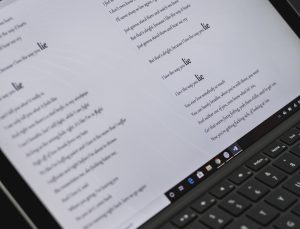When we write song lyrics, texts that aspire to fit into a melody and be part of a complete song, we have to think that not just any type of writing is going to make that happen.
 The first metric verse These lyrics, like sisters of the poems that they are, will practically always require a structure, a form that adapts to the musical discourse, its rhythm, the space through which the melody, especially, will travel. express what we want to say in it. Let's look at some basic characteristics that affect the verses that are sung, the so-called meter in the lyrics of the songs.
The first metric verse These lyrics, like sisters of the poems that they are, will practically always require a structure, a form that adapts to the musical discourse, its rhythm, the space through which the melody, especially, will travel. express what we want to say in it. Let's look at some basic characteristics that affect the verses that are sung, the so-called meter in the lyrics of the songs.
Meter, poetry and songs
Writing the lyrics of a song, as we have said, is more than simply writing down the first thing that comes to mind and the meter is one of the aspects that will most influence whether we can read it as a text intended to carry music. This topic will probably sound familiar to you from school, from the study of poetry in literature or from your own interest in the field of poetry.
What is literary meter?
As a reminder, then, we will say that the metrics It is the set of regular segments that characterize versified poetry and rhythmic prose. Basically: the versethe stanza and the poem. For our particular case, the lyrics of a song are the container of those verses and stanzas. Whether a lyric is considered a poem or poetry or any other form is a separate discussion that we will not go into here. To explain this very important aspect of song lyrics, we will use literary references since, as we have commented on other occasions, they are a literary form. In the Spanish language metric, the verse It is basically made up of a more or less fixed number of syllables and a certain distribution of accents. In other languages and cultural traditions, other ways of measuring and ordering these recurrences have been used, such as, for example, the internal alliteration of Germanic and Scandinavian verses, or the so-called Greek or Latin feet, formed by a reduced number of long and short syllables. .
Count syllables and verses in a song
So, you have to tell, yes, you know. Let's remember the details. The words are acutewhen the last syllable is stressed, flatwhen the penultimate syllable is the strong or esdrújulaswhen the stress is on the penultimate syllable. We continue. The conventions used to count the number of syllables in a verse written in the Spanish language are: If the verse ends in a word acuteit is told one more syllable.If the verse ends in a word plain, no syllables are added or subtracted metrics.If the verse ends in a word esdrújulait is told one syllable less. We must take into account the phonetic relationships between adjacent vowels, which we study in school language class. If you don't remember them, there are many tutorials out there, but in the way you speak you will find most of the answers to the metric questions that may arise. The diphthongs or syllabic union of adjacent vowels and the hiatuses or separation in a word, and its equivalents sinalefa and dialefa between adjacent words, are the keys to correct syllable counting. Furthermore, there are exceptions, also called licensesto square the meter of the verses or to produce specific effects in pronunciation or rhythm. In general we have two groups: those that eliminate or add sounds or phonemes to words and the so-called accent dislocation which stresses a weak or unstressed syllable and turns the original strong syllable into a weak one. But the verses do not necessarily have to be subject to a certain meter. The call free versefor example, is not subject to rhyme or measure. We continue with this little literature class.
 Verses
Verses
Types of verses
According to this criterion, there are four main types of verses: from shortest to longest, they are those of minor artthose of major artthe compounds and the verse. He minor art It is made up of verses that have up to eight syllables. He major arton the contrary, is made up of verses that have nine or more syllables. Verses of more than eleven syllables, called composites of major arthave a constant internal division or caesura, a pause fixed towards their middle. To finish, the versewhich is an irregular verse with no fixed number of syllables and generally so long that it overflows the highest art.
Rhythm and metric accents
But verses can also be organized internally by fixed accents on certain syllables, rather than on a total of syllables per line. For example, the hendecasyllable stressed on the first and sixth syllables is called emphatic; the accented in second and sixth, heroic; and the accented in third and sixth, melodicgiving each of them a different expressiveness. There are two types of verbal rhythms, mainly, in Spanish verse: If we divide the verse into parts of two syllables: the one that emphasizes odd syllables or trochaic rhythm and the one who tries to accentuate the evens, or iambic rhythm. If, on the other hand, we divide the verse into groups of three syllables We have three types of rhythms, depending on whether we accentuate the first, second or third syllable of each three. he dactylic rhythmhe amphibrachic and the anapaesticfollowing the tradition of feet in classical Greco-Latin poetry. Although it may seem impossible, although it sounds like the oldest thing in the world, these types of rhythmic games within the verse are often used by rappers or improvisers in hip hop, using triplets and other rhythmic figures in their phrasing, although in a way very free. And that's it, our friend, the verse.
 Words with their meter
Words with their meter
The stanzas
These verses are usually grouped into stanzas, which in terms of meter are a set of verses with a fixed distribution of syllables that is repeated regularly in the same poem. Verses, in their various forms, are the main sections that structure the lyrics of a song. They will be choruses, pre-choruses, bridges or any other functional block in the song, but they will usually have their own structure and some relationship with the rest. Often, the stanza contains a complete thought, so it has a certain semantic autonomy. The stanzas of the Castilian meter comprise between two and thirteen verses. Some stanzas would be:
Couplets (stanzas of two rhymed lines) trio It is made up of three generally hendecasyllabic verses (11 syllables), influenced by the Italian Renaissance. Among the stanzas of 4 verses we can mention the assonant quatrain either coupletwhich is a group of four octosyllabic verses. From five verses we find the lira, which is a stanza of five verses of seven and eleven syllables. The sextille It is the combination of six short verses, generally octosyllabic. The pamphletstanza of eight short lines; The most common is made up of octosyllables, rhymed in very different ways. Among the verses of ten syllables, the tenth. It is a stanza made up of 10 eight-syllable verses that join or group two limericks as semi-stanzas. Rhyme plays an important role in distinguishing one type of stanza from another.
 Access to lyrics in an app
Access to lyrics in an app
Conclusions
In summary, we must highlight and realize that the relationship between the melody of a song and its lyrics, each with its own sound and rhythm, are the key point where these two worlds meet, the musical and the meaningful. They could have existed separately as poetry or text and instrumental music, for example, but their union, the relationship they establish with each other, will mark the meaning of the whole and will found what we call “song.” The meters in the lyrics of the songs have evolved over time, like everything, and have gone through historical and social contexts of greater restriction or greater freedom. You may find this whole verse length thing boring or unhelpful, or you may feel limited in having to consider this element of lyrics in songs. If so, I have good news for you. Song lyrics do not have to be poems or poetry, although some of them can be considered that way. The fact is that, unlike poetry, which only has the music and rhythm of its own words, its organization and its rhyme to show itself, song lyrics have powerful allies: melody, rhythm and harmony. So, don't hesitate and write your song. #mailpoet_form_3 .mailpoet_form { } #mailpoet_form_3 .mailpoet_column_with_background { padding: 10px; } #mailpoet_form_3 .mailpoet_form_column:not(:first-child) { margin-left: 20px; } #mailpoet_form_3 .mailpoet_paragraph { line-height: 20px; margin-bottom: 20px; } #mailpoet_form_3 .mailpoet_segment_label, #mailpoet_form_3 .mailpoet_text_label, #mailpoet_form_3 .mailpoet_textarea_label, #mailpoet_form_3 .mailpoet_select_label, #mailpoet_form_3 .mailpoet_radio_label, #mailpoet_form_3 .mailpoet_checkbox_label, 3 .mailpoet_list_label, #mailpoet_form_3 .mailpoet_date_label { display: block; font-weight: normal; } #mailpoet_form_3 .mailpoet_text, #mailpoet_form_3 .mailpoet_textarea, #mailpoet_form_3 .mailpoet_select, #mailpoet_form_3 .mailpoet_date_month, #mailpoet_form_3 .mailpoet_date_day, #mailpoet_form_3 .mailpoet_date_year, #mailpoet_form_3 .mailpoet_date { display :block; } #mailpoet_form_3 .mailpoet_text, #mailpoet_form_3 .mailpoet_textarea { width: 200px; } #mailpoet_form_3 .mailpoet_checkbox { } #mailpoet_form_3 .mailpoet_submit { } #mailpoet_form_3 .mailpoet_divider { } #mailpoet_form_3 .mailpoet_message { } #mailpoet_form_3 .mailpoet_form_loading { width: 30px; text-align: center; line-height: normal; } #mailpoet_form_3 .mailpoet_form_loading > span { width: 5px; height: 5px; background-color: #5b5b5b; }#mailpoet_form_3{border: 1px solid #fcb900;border-radius: 40px;text-align: center;}#mailpoet_form_3 form.mailpoet_form {padding: 20px;}#mailpoet_form_3{width: 70%;}#mailpoet_form_3 .mailpoet_message {margin : 0; padding: 0 20px;}#mailpoet_form_3 .mailpoet_paragraph.last {margin-bottom: 0} @media (max-width: 500px) {#mailpoet_form_3 {background-image: none;}} @media (min-width: 500px) { #mailpoet_form_3 .last .mailpoet_paragraph:last-child {margin-bottom: 0}} @media (max-width: 500px) {#mailpoet_form_3 .mailpoet_form_column:last-child .mailpoet_paragraph:last-child {margin-bottom: 0}} Please leave this field emptyDo you write songs or would you like to?
Email * I have read and accept the Privacy Policy With the Guide «The journey of a song» as a gift Check your inbox or spam folder to confirm your subscription.

